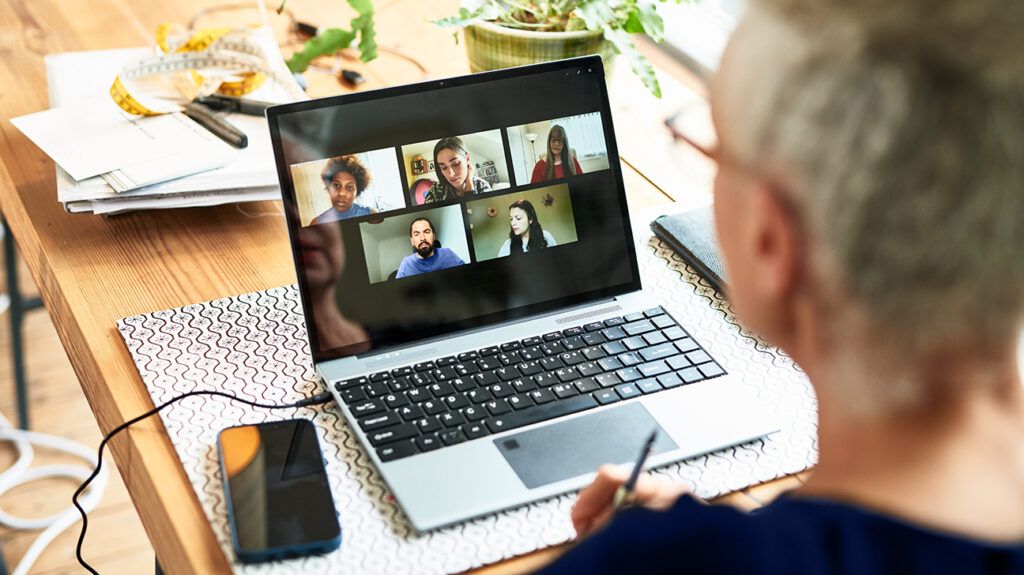Video conferencing is likely here to stay. So let’s get more familiar with what exactly Zoom anxiety is and how to manage it.

In-person meetings can be anxiety-inducing enough. Many of us wonder when we should listen and when we should talk. And when we finally do talk, what should we say and how should we say it?
If that isn’t stressful enough, a virtually brand-new source of anxiety rose out of the COVID-19 pandemic: Zoom anxiety.
Now we have another collection of meeting-related worries: “Do I look directly into the camera or at their faces? Is my backdrop OK? Can they hear my dog scratching at the door? Are they even listening, or are they checking emails?”
Most of us can relate to the experience of beginning a lengthy response, only to realize that people have been waving you down because you’ve been on mute the whole time.
Since COVID-19 protocols disrupted the usual flow of many workplaces, video conferencing has become a popular form of professional communication. Even as we return to business-as-usual, “normal” for many workplaces may involve more virtual meetings.
Zoom anxiety overlaps with what researchers call Zoom fatigue — a strong sense of post-meeting exhaustion. If virtual meetings make you both tired and anxious, you might experience physical anxiety symptoms or panic in addition to the fatigue.
Besides leading to exhaustion in professional settings, Zoom anxiety is also impacting students. A study involving college students found that 80% of the students polled said they experienced more anxiety and trouble focusing in virtual classes.
Not everyone who experiences Zoom anxiety has a diagnosable anxiety disorder per the Diagnostic and Statistical Manual of Mental Disorders (DSM-5). But if you do live with an anxiety disorder, Zoom meetings could become another source of anxiety.
Zoom anxiety often causes physical symptoms like:
- increased heart rate
- sweating
- shortness of breath
- lightheadedness
- dizziness
- nausea
- stomach pain
- tension
Zoom anxiety can also make you feel:
- nervous and uneasy during meetings
- afraid to speak up
- frustrated or left out of the loop
- forgetful, like you’re experiencing stage fright
- stressed or less productive leading up to the meeting
And it’s not just the Zoom platform that can cause these feelings of unease. Other video chat tools like Google Hangouts and Skype are having this same effect.
Research suggests that a bigger cognitive load could help explain why virtual meetings can be more stressful.
Some researchers posit that the increased amount of eye contact and the size of your coworkers’ faces on-screen mean you’re required to process more nonverbal cues than if you were looking at only one speaker in an in-person setting.
Another study backs up the idea that Zoom anxiety and fatigue are tied to nonverbal cues. It suggests that the following factors contribute to that sense of dread and exhaustion around meetings:
- mirror anxiety, or anxiety caused by seeing your own face on the screen
- feeling trapped, like you can’t move too much during the meeting
- feeling watched by everyone else on the call
- bigger cognitive load from putting out and taking in more social cues
The same study also found that women tend to experience more Zoom fatigue than men. In particular, women had much higher rates of mirror anxiety and self-consciousness.
If you already live with an anxiety disorder — particularly social anxiety disorder — you might find that virtual meetings intensify your symptoms.
Since social anxiety tends to go hand-in-hand with self-consciousness, seeing yourself on-screen during meetings may be especially anxiety inducing.
You might experience the following if you live with social anxiety:
- dread or trouble focusing on your work leading up to the meeting
- distress about not knowing where to look during the meeting
- worry about when to speak up (and how long to keep talking)
- stage fright when it’s your turn to speak
- intense worries about technical glitches during the meeting
- difficulty focusing or losing your train of thought due to feeling watched
- mental and physical exhaustion or brain fog after the meeting
Social anxiety disorder can cause you to worry about being judged, humiliated, or rejected during interactions with others. While more research is needed to confirm this, it may follow that the feeling of being watched that comes with large virtual meetings could bring some people’s anxiety to a new level.
If you’re experiencing Zoom fatigue and anxiety, you may be wondering how you can feel more at ease during video calls. Here are some tips:
Minimize your mirror
If you experience high levels or mirror anxiety or self-consciousness in virtual meetings, consider changing up some settings. Rather than opting for a view of both yourself and those you’re talking with, you might select a view that minimizes your own screen, making your reflection less visible to you.
In Zoom, there’s also an option to “Hide Self View.” This makes for a more real-life interaction since you don’t see yourself when you communicate.
Go audio-only
When possible, consider turning off your video altogether. If seeing the faces of others is adding to your anxiety, you could even minimize their screens and treat the meeting like a phone call.
Even if going audio-only isn’t an option for every meeting, try to go audio-only in as many meetings as you can. This can still help you reduce fatigue and anxiety.
Switch to ‘speaker only’
If seeing multiple faces (and sets of eyes) staring back at you is making it harder to focus, it might be time to change up your settings again. Many virtual meeting platforms — including Zoom — have an option that changes your view to only one person at a time: the person who’s currently speaking.
Move mindfully
Another source of Zoom anxiety can come from feeling like you can’t move too much during the meeting — because on screen, every move you make might seem much more noticeable.
But during phone calls and in-person meetings, it’s natural for people to stretch, readjust themselves, or get up for a glass of water. It’s OK to bring that same mindset and energy to the table virtually.
For instance, you might remind yourself to:
- stretch your arms or neck if they’re feeling tense
- sip on some water or coffee
- let your colleagues know you’ll BRB to grab a snack or drink
- take a moment to feel your feet on the floor or press them down alternately to ground yourself
Even though work-from-home and remote work have eased anxiety and stress for many people, this new situation isn’t free from other sources of anxiety.
It’s valid to feel more stress and fatigue because of virtual meetings. As many people adjust to this new way of interacting, it may help not only to develop skills that help you manage the anxiety, but also to figure out ways to change how you interact with Zoom.
A variety of strategies can help you address and reduce anxiety before, during, and after virtual meetings. Remember to bring in some self-compassion and patience as you navigate this relatively new territory alongside the people you work with.
